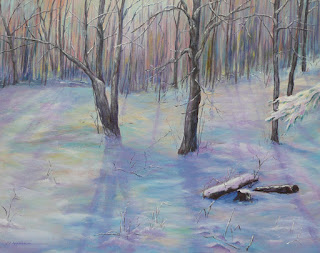FOR MY PAINTING STUDENTS
It has been a couple of weeks since our last class and in the time in between I have finished the painting Winter Morning, framed it and delivered it to the Painting the Winter show at the Thousand Islands Arts Center in Clayton.
I had been planning on speaking to the class on a few points concerning color mixing with a limited palette. The painting would have been great for the demo, but I really needed to get it finished and off to the show. So, we will use the blog as a way to finish this particular lesson.The intent for this painting was to portray the effect of early morning light on the snow covered ground. Using a photo as a starting point I sketched the main parts of the painting, which also happens to be the focal point. The group of 3 or 4 trees in the foreground is my focal point. I have a secondary focal point, which are the logs in the lower right corner. They are considered a secondary focal point because they help lead our eyes to the main grouping of trees. Most of the trees in the background were not sketched except for a few of the more prominent trees. After underpainting in complementary colors I began to work toward bringing my colors closer to the real or local color.
The snow had a warm yellow and orange underpainting which helped with conveying the idea of sunlight on the snow. I used titanium white combined with a touch of soft blues and purples to bring my snow closer to conventional snow colors.
When it was time to paint the long shadows stretching across the snow I chose deeper versions of the same blues and purples, but kept my lines soft and diffused so that the shadows appeared to fall across a soft new-fallen snow, rather than a hard surface. The trees in the background are implied with a series of vertical strokes rather than carefully painted, so as not to detract from the focal point.
A combination of lighter and darker colors was used to create a sense of depth. The trees in the foreground have the appearance of being painted in various shades of brown, but no real brown was on the palette. Instead, a "brown" was created by mixing the blues and purples already on the palette with a warm cadmium red. Those three colors in various combinations made up most of the colors in the trees in the foreground and in the backgound. A touch of white here and there was used to lighten the colors. Creating new colors, especially those neutrals, can be done very effectively by using the colors on your palette, those colors that are already in your painting. This creates a type of color harmony, which re-inforces composition. Using color in this way can also "save" a weak composition.
All finishing touches, like the small snow covered twigs and branches was done last, after the color adjustments on the background, middleground and foreground were done. Before finishing touches are applied it is important to step away from your painting for a bit, then come back to look at it with fresh eyes. This is the time to make color adjustments on the large background surfaces especially. When color temperature (warm/cool)and harmony are adjusted, then finishing touches can be applied.


